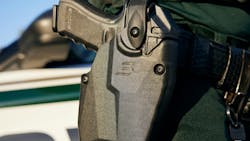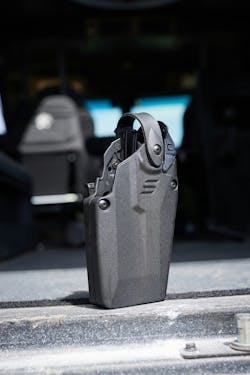Safariland and the History of Duty Holster Security Levels
Safariland is a long known, easily recognized and well trusted name in the holster industry (among several other law enforcement product industries). In fact, dating back to 1964 (60 years ago!) when it was founded by Neale Perkins specifically to manufacture a custom holster, it’s one of the oldest, if not the oldest, holster manufacturing companies in existence today.
This article appeared in the July/August issue of OFFICER Magazine. Click Here to subscribe to OFFICER Magazine.
Earlier this year, near the end of spring in Deland, Florida, Safariland hosted a training and education event that offered attendees some truly unique training opportunities but also provided education on holster design and retention levels. One thing that became obvious during that event was that many shooters, officers, trainers and others who use, wear or carry handguns had a misunderstanding of how the duty holster retention system was originally developed and what it’s intended to mean.
One officer we spoke to who began his career in the mid-1980s freely spoke of his first Level III retention duty holster. No one had ever instructed him on what the “Level III” part of that meant and since the holster had three design features, each providing some type of retention, he wrongly assumed that “Level III” meant three retention devices. In the case of that early duty holster (early for him) it was the snapping thumb strap, the internal trigger guard hook and the tension screw which could be adjusted to increase or decrease friction between the holster body and the weapon. By tightening the screw, the user could make the weapon more difficult to draw.
Here is the most important comment on that officer’s understanding of retention levels and design features: No one ever corrected him. He spent the next 30 years of his career working under the assumption that one security device equaled one level of retention. Two devices equaled Level II. Three devices equaled Level III. In reality, back when Safariland first started giving their holster security or duty retention level ratings, it was never meant to be about, or based on design features or devices. It was meant to be, and remains, about the number of specific motions required to present the weapon from the holster.
During the training event Safariland hosted, it became obvious from the conversations held that there was a common misperception regarding duty holster retention levels and the need for it to be correctly addressed. Like the one officer mentioned above, the belief that the retention level number equaled the number of devices designed into the holster, even if all could be released/disabled with a single motion, continued to grow and flourish.
Then came the “rabbit hole” discussion: If the retention level rating is based on the number of motions required to present the handgun from the holster, couldn’t some instructors make any holsters a Level V, VI or VII holster? Couldn’t they specify so many specific “motions” of the shooting hand and arm that any holster could add multiple retention levels? It was agreed that if such people (those “expert” instructors who often just try to make a name for themselves anyway possible) tried to reclassify any holster with a higher retention level based on their training and not the holster design/operation, that such people would be recognized and called out for their… misrepresentation.
Keep all this in mind the next time you are selecting a duty holster, or even an off-duty holster (the Safariland SOLIS incorporates their ALS security device but it is meant for plainclothes/off-duty use). If a holster has multiple retention devices that all get released or disabled with a single motion, then the inventor of the duty holster retention level rating system would classify it as a Level I holster. It is the number of specific motions required to disable the retention devices that determines the security level of the holster, not the number of devices designed into it.
About the Author
Lt. Frank Borelli (ret), Editorial Director
Editorial Director
Lt. Frank Borelli is the Editorial Director for the Officer Media Group. Frank brings 20+ years of writing and editing experience in addition to 40 years of law enforcement operations, administration and training experience to the team.
Frank has had numerous books published which are available on Amazon.com, BarnesAndNoble.com, and other major retail outlets.
If you have any comments or questions, you can contact him via email at [email protected].


